
Robert Philip Hanssen is an American former Federal Bureau of Investigation (FBI) double agent who spied for Soviet and Russian intelligence services against the United States from 1976 to 2001. His espionage was described by the Department of Justice as "possibly the worst intelligence disaster in U.S. history." Hanssen is currently serving 15 consecutive life sentences without parole at ADX Florence, a federal supermax prison near Florence, Colorado.

Aldrich Hazen "Rick" Ames is a former Central Intelligence Agency (CIA) officer turned KGB double agent, who was convicted of espionage in 1994. He is serving a life sentence, without the possibility of parole, in the Federal Correctional Institution in Terre Haute, Indiana, United States. Ames was formerly a 31-year CIA counterintelligence officer who committed espionage against the U.S. by spying for the Soviet Union and Russia. At the time of his arrest, Ames had compromised more highly classified CIA assets than any other officer in history until Robert Hanssen's arrest seven years later in 2001.
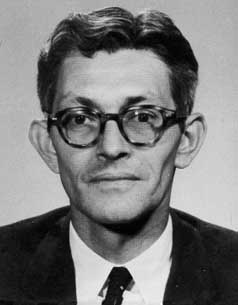
James Jesus Angleton was chief of counterintelligence for the Central Intelligence Agency (CIA) from 1954 to 1974. His official position within the organization was Associate Deputy Director of Operations for Counterintelligence (ADDOCI). Angleton was significantly involved in the US response to the purported KGB defectors Anatoliy Golitsyn and Yuri Nosenko. Angleton later became convinced the CIA harbored a high-ranking mole, and engaged in an intensive search. Whether this was a highly destructive witch hunt or appropriate caution vindicated by later moles remains a subject of intense historical debate.

Spycatcher: The Candid Autobiography of a Senior Intelligence Officer (1987) is a memoir written by Peter Wright, former MI5 officer and Assistant Director, and co-author Paul Greengrass. He drew on his own experiences and research into the history of the British intelligence community. Published first in Australia, the book was banned in England due to its allegations about government policy and incidents. These efforts ensured the book's notoriety, and it earned considerable profit for Wright.

Oleg Vladimirovich Penkovsky, codenamed HERO, was a Soviet military intelligence (GRU) colonel during the late 1950s and early 1960s. Penkovsky informed the United Kingdom about the Soviet emplacement of missiles in Cuba, which provided both the UK and the US with the precise knowledge necessary to address rapidly developing military tensions with the Soviet Union.
Karel František Koecher is a mole known to have penetrated the CIA.
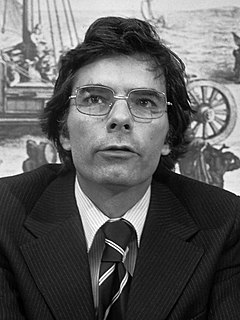
Philip Burnett Franklin Agee was a Central Intelligence Agency (CIA) case officer and writer of the 1975 book, Inside the Company: CIA Diary, detailing his experiences in the CIA. Agee joined the CIA in 1957, and over the following decade had postings in Washington, D.C., Ecuador, Uruguay and Mexico. After resigning from the Agency in 1968, he became a leading opponent of CIA practices. A co-founder of the CounterSpy and CovertAction series of periodicals, he died in Cuba in January 2008.
Anatoliy Mikhaylovich Golitsyn CBE was a Soviet KGB defector and author of two books about the long-term deception strategy of the KGB leadership. He was born in Pyriatyn, USSR. He provided "a wide range of intelligence to the CIA on the operations of most of the 'Lines' (departments) at the Helsinki and other residencies, as well as KGB methods of recruiting and running agents." He was an Honorary Commander of the Order of the British Empire (CBE) and, as late as 1984, was an American citizen.
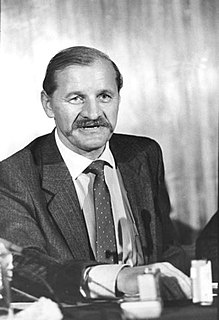
Vitaly Sergeyevich Yurchenko is a former high-ranking KGB officer in the Soviet Union. After 25 years of service in the KGB, he defected to the United States during an assignment in Rome. After providing the names of two U.S. intelligence officers who were KGB agents, Yurchenko slipped from the Americans and returned to the Soviets. Although it is unclear whether his initial defection was legitimate, Yurchenko was awarded the Order of the Red Star from the Soviet government for the successful "infiltration operation."
George Kisevalter was an American operations officer of the CIA, who handled Major Pyotr Popov, the first Soviet GRU officer run by the CIA. He had some involvement with Soviet intelligence Colonel Oleg Penkovsky, active in the 1960s, who had more direct relations with British MI-6.
Yuri Ivanovich Nosenko was a KGB officer who defected to the United States in 1964. Controversy arose in the CIA over whether he was a bona fide defector and he was held in detention for over three years before he was finally accepted as a legitimate defector by the CIA. After his release, he became an American citizen, working as a consultant and trainer for the CIA.

Michał Goleniewski a.k.a. 'SNIPER', 'LAVINIA',, was a Polish officer in the People's Republic of Poland's Ministry of Public Security, the deputy head of military counterintelligence GZI WP, later head of the technical and scientific section of the Polish intelligence, and a spy for the Soviet government during the 1950s. In 1959, he became a triple-agent, giving Polish and Soviet secrets to the Central Intelligence Agency, which directly caused the exposure of George Blake and Harry Houghton. Goleniewski defected to the United States in 1961. He later made unsubstantiated claims to be Tsarevich Alexei Nikolaevich of Russia.
Heinz Paul Johann Felfe was a German spy.
Sasha was an alleged Soviet mole in the Central Intelligence Agency during the Cold War.
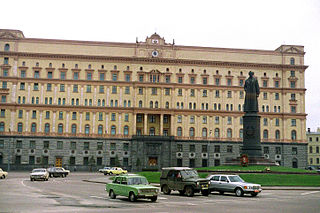
The KGB, translated in English as the Committee for State Security, was the main security agency for the Soviet Union from 13 March 1954 until 3 December 1991. As a direct successor of preceding agencies such as the Cheka, GPU, OGPU, NKGB, NKVD and MGB, it was attached to the Council of Ministers. It was the chief government agency of "union-republican jurisdiction", carrying out internal security, intelligence and secret police functions. Similar agencies operated in each of the republics of the Soviet Union aside from the Russian SFSR, with many associated ministries, state committees and state commissions.
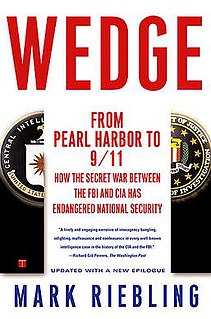
Wedge: The Secret War Between the FBI and CIA, a nonfiction book by American historian and policy analyst Mark Riebling, explores the conflict between U.S. domestic law enforcement and foreign intelligence. The book presents FBI–CIA rivalry through the prism of national traumas—including the Kennedy assassination, Watergate, and 9/11—and argues that the agencies' failure to cooperate has seriously endangered U.S. national security.
Aleksander Grigoryevich Kopatzky was a Soviet double agent, who was unmasked in 1961 by Anatoliy Golitsyn. Kopatzky also used the names Igor Orlov, Aleksandr Navratilov and Calvus, and his Soviet codenames were Erwin, Herbert and Richard.
Leslie James Bennett was a British/Canadian citizen who spent most of his working life as a counter-intelligence official, first for Britain's GCHQ, and later for the Royal Canadian Mounted Police (RCMP) Security Service. He took an early retirement and moved to Australia.
The Martel affair, sometimes known as the Sapphire affair, was a spy scandal that took place in France in early 1962. It involved information provided by former high-ranking member of the KGB, Anatoliy Golitsyn, who defected to the United States in December 1961. Golitsyn stated that the Soviets had agents placed throughout French military intelligence and even within French President Charles de Gaulle's cabinet. He claimed that these agents had access to any NATO document on demand.
David Henry Blee served in the Central Intelligence Agency (CIA) from its founding in 1947 until his 1985 retirement. During World War II in the Office of Strategic Services (OSS), he had worked in Southeast Asia. In the CIA, he served as Chief of Station (COS) in Asia and Africa, starting in the 1950s. He then led the CIA's Near East Division.









